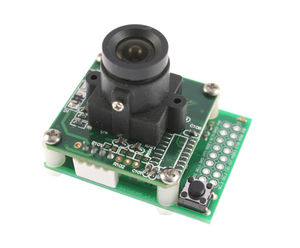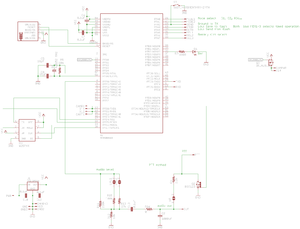Difference between revisions of "SSTVCAM"
(→Solder Jumpers) |
(No difference)
|
Latest revision as of 14:21, 13 February 2013
The Argent Data Systems SSTVCAM module is a self-contained slow-scan television encoder with an integrated digital camera.
Contents
Features
- Scottie 1, Scottie 2, Robot 36 and Robot 72 modes
- Manual trigger or automatic timed operation
- 8 frames of non-volatile image storage
- Character encoder for Scottie modes
- 60 degree FOV with standard lens
- 75 mA current draw while transmitting, 3.5 mA idle
Hardware Description
The SSTVCAM board measures 1.5" by 1.28" (38mm by 35mm) and is 0.85" (22mm) high with the camera installed. It weighs approximately 1/3 ounce (9 grams.) At a minimum, the board requires a power supply and connection to the transmitter's microphone input.
Pinouts
| Pin | Function |
|---|---|
| PWR | Power input - 5 to 12 volts DC |
| GND | Ground |
| GND3 | Ground |
| SEND | Sends or stores a frame |
| RETR | Selects memory retrieve mode |
| STOR | Selects memory store mode |
| MODE1 | Selects SSTV format |
| MODE2 | Selects SSTV format |
| PTT | Open collector push-to-talk output |
| OUT | Audio output |
| RXD | Serial data input (LVTTL) - 3.3v max |
| TXD | Serial data output (LVTTL) |
| SEL1 | Selects memory slot or timer interval |
| SEL2 | Selects memory slot or timer interval |
| GND2 | Ground |
| SEL3 | Selects memory slot or timer interval |
Note that while the unit will function with a 12 volt input, higher input voltages may generate excessive heat at the voltage regulator when the camera is operating. A supply voltage of 9 volts or less is recommended.
The GND, RX, TX, and 3.3V pads across the bottom of the board are provided for remote connection of the camera module. Cable length should be kept to not more than a few inches.
Solder Jumpers
| Jumper | Function |
|---|---|
| HT | Selects handheld PTT mode |
| SJ1 | Increases audio output level |
| SJ2 | Increases audio output level |
Operation
All of the digital inputs on the SSTVCAM are active low - grounding a pin sets it 'on'. The SSTV format to be used is selected by the MODE1 and MODE2 inputs, as follows:
| MODE1 | MODE2 | Format |
|---|---|---|
| Off | Off | Robot 36 |
| On | Off | Robot 72 |
| Off | On | Scottie 2 |
| On | On | Scottie 1 |
If STOR and RETR are off, pressing button S1 or momentarily grounding the SEND line triggers an immediate transmission in the selected mode. If STOR is on, a frame will be saved to the memory slot selected by SEL1-SEL3. If RETR is on, a previously saved frame will be sent from the selected memory slot. If both STOR and RETR are on, the unit will operate in self-timed mode, sending frames automatically with a delay between each frame specified by SEL1-SEL3, as follows:
| SEL1 | SEL2 | SEL3 | Delay |
|---|---|---|---|
| Off | Off | Off | 0 seconds |
| On | Off | Off | 10 seconds |
| Off | On | Off | 30 seconds |
| On | On | Off | 60 seconds |
| Off | Off | On | 120 seconds |
| On | Off | On | 300 seconds |
| Off | On | On | 600 seconds |
| On | On | On | 1200 seconds |
Character Generator
A 1-line character generator occupies the top of the frame in Scottie mode. By default, this line displays the SSTVCAM version and a frame sequence number. The contents of the line can be changed by sending serial data to the unit through the RXD line at 4800 baud with LVTTL (0 to 3.3v) signal levels. Sending a carriage return or linefeed moves the cursor to the start of the line.
Starting with firmware version 1.2, sending an end-of-text (control-C) signal causes the SSTVCAM to save the current line of text to non-volatile memory.


